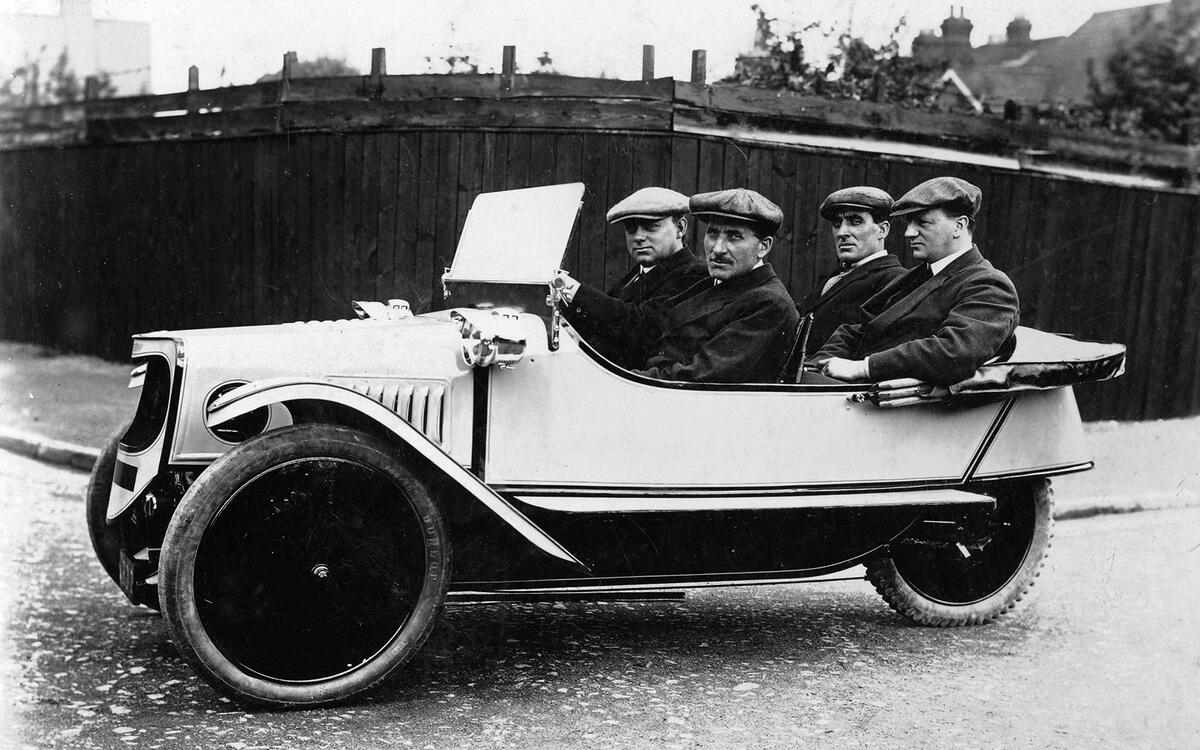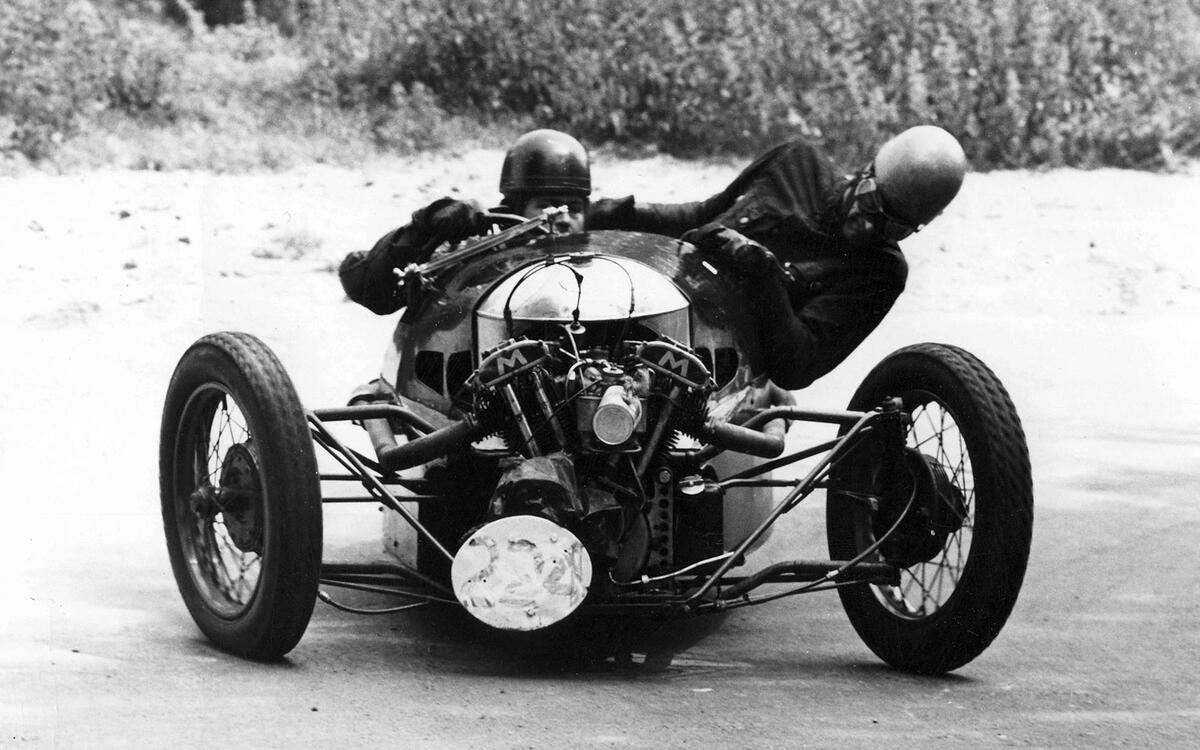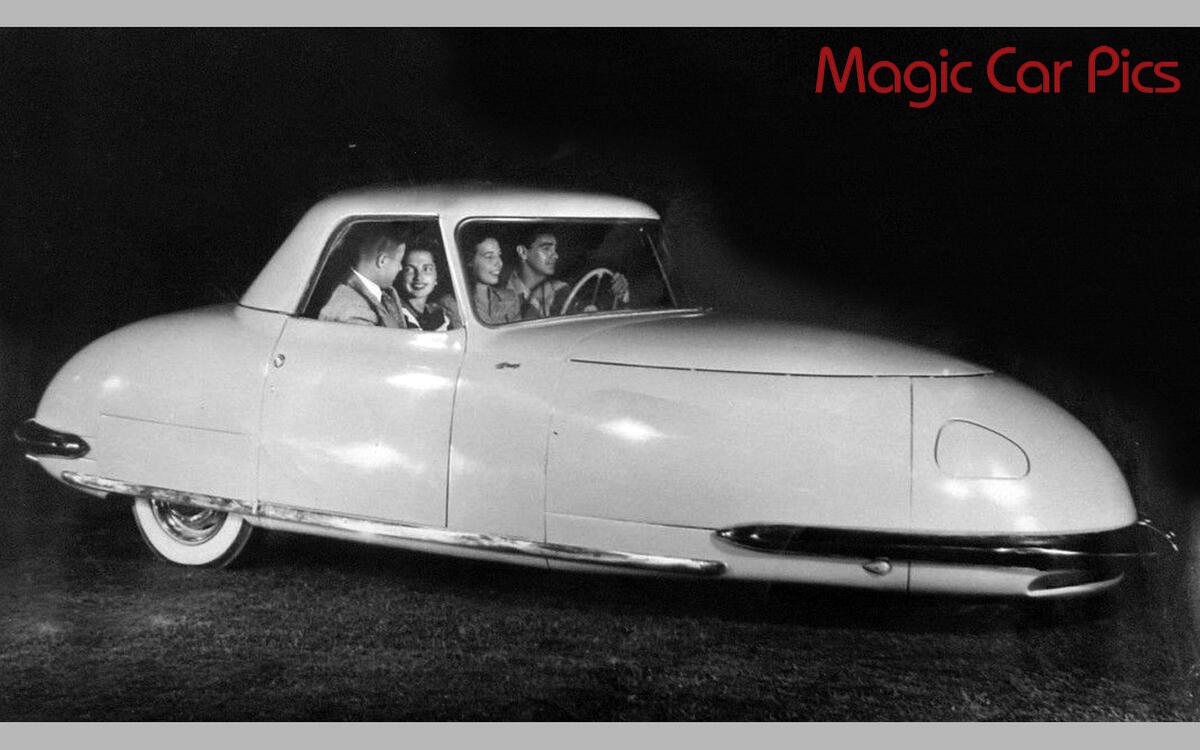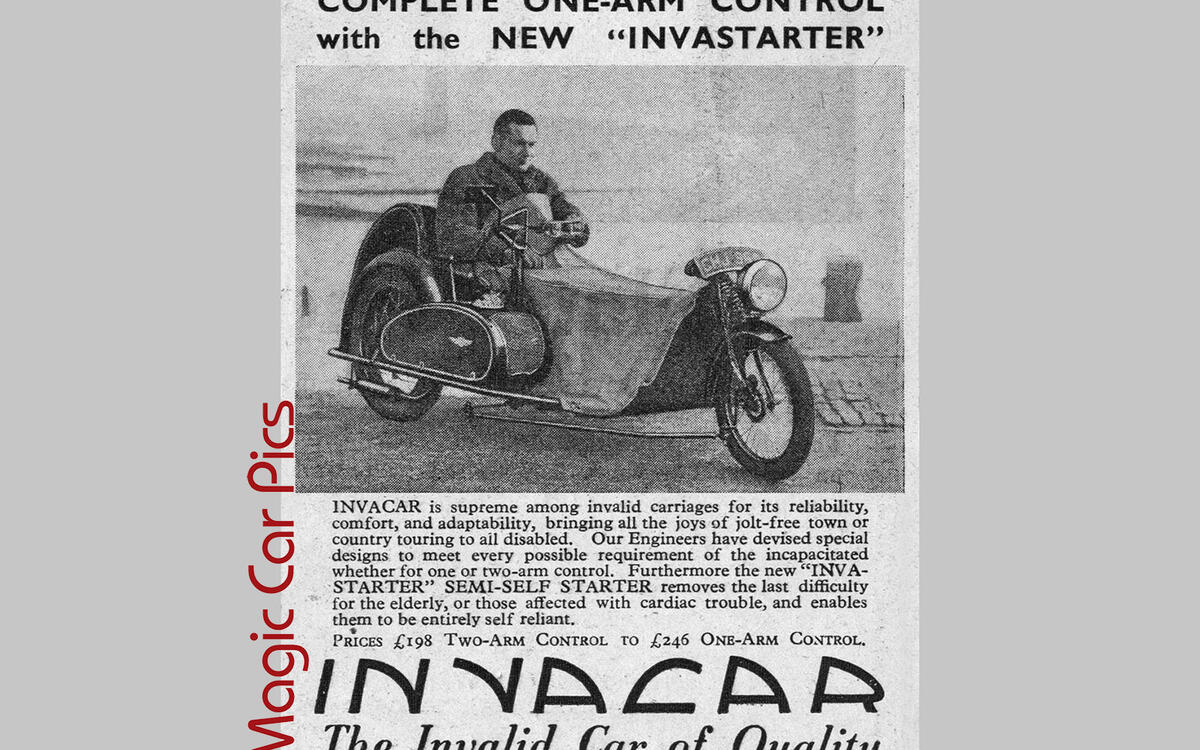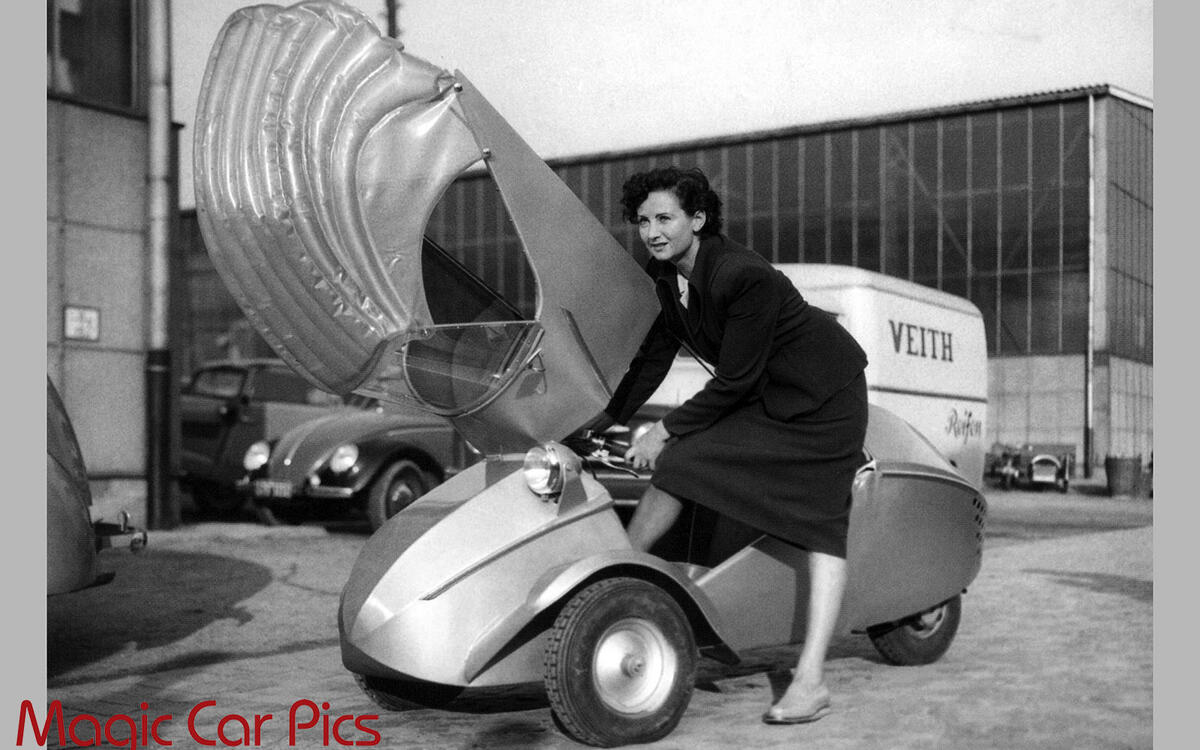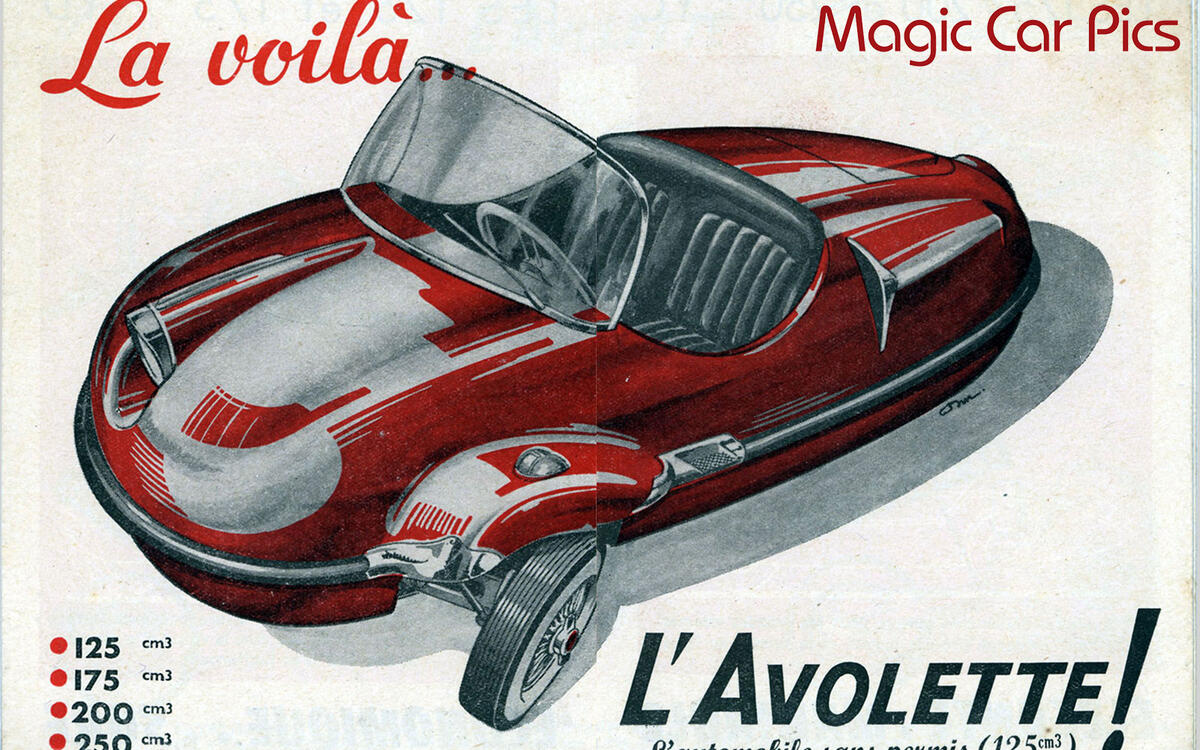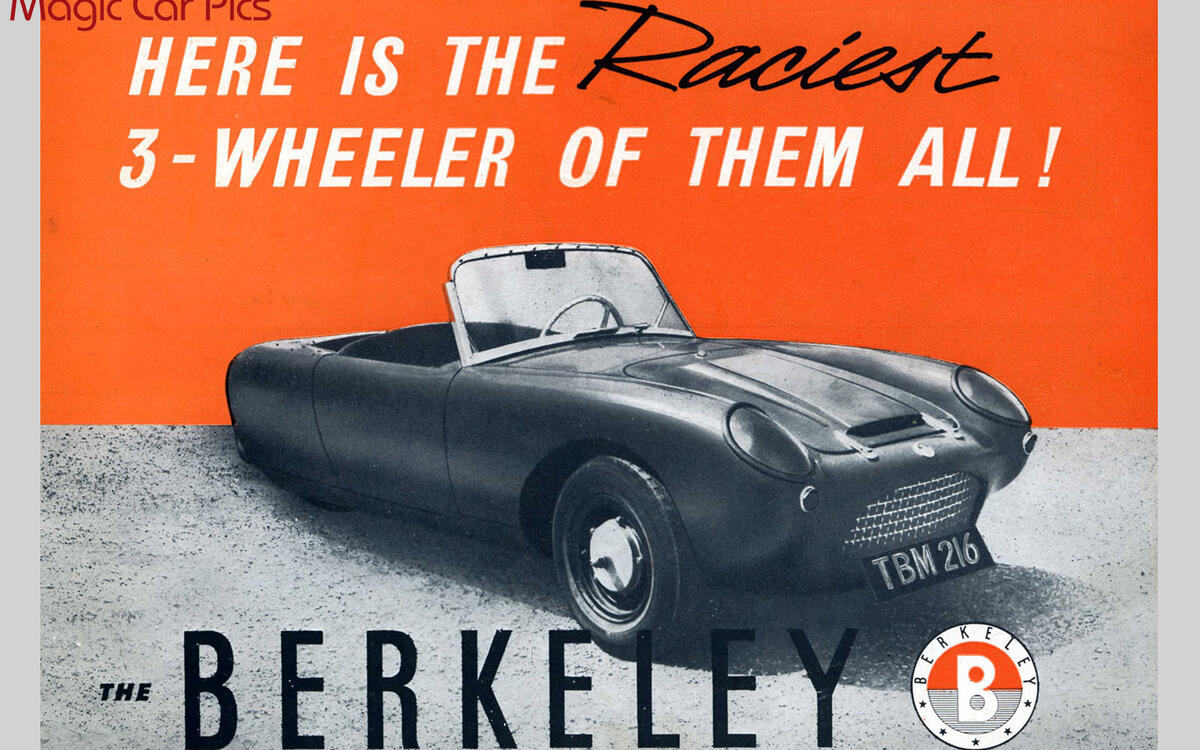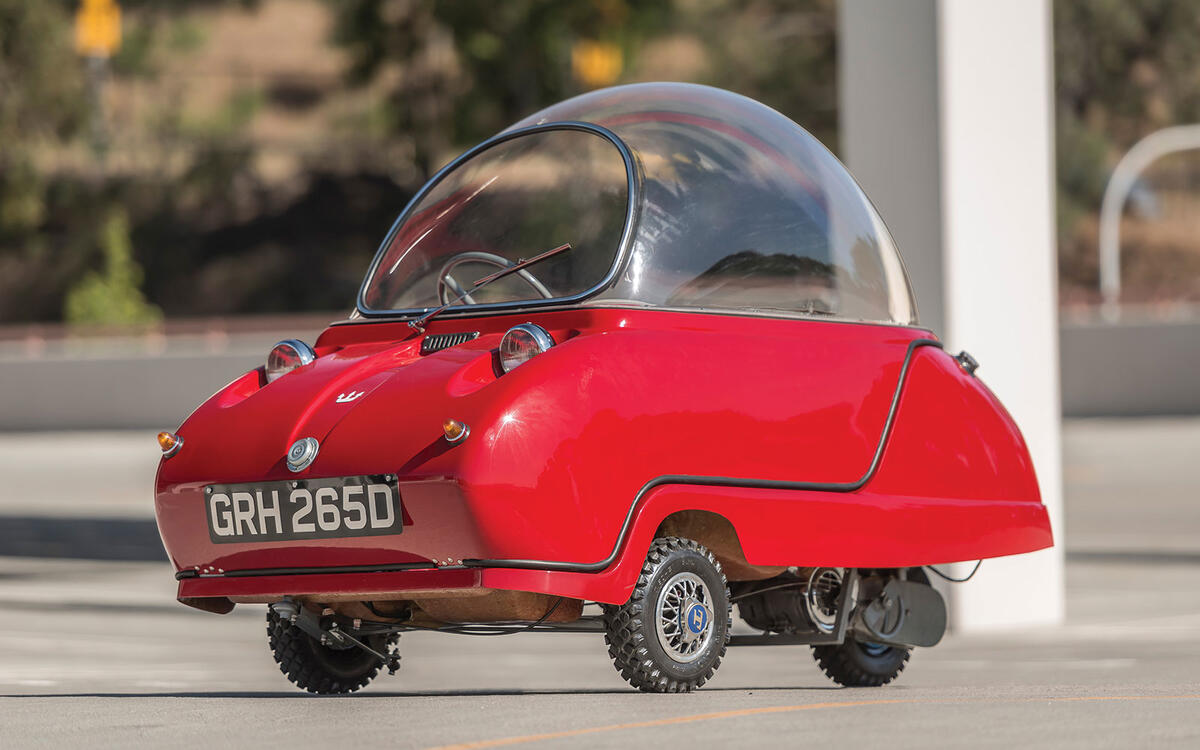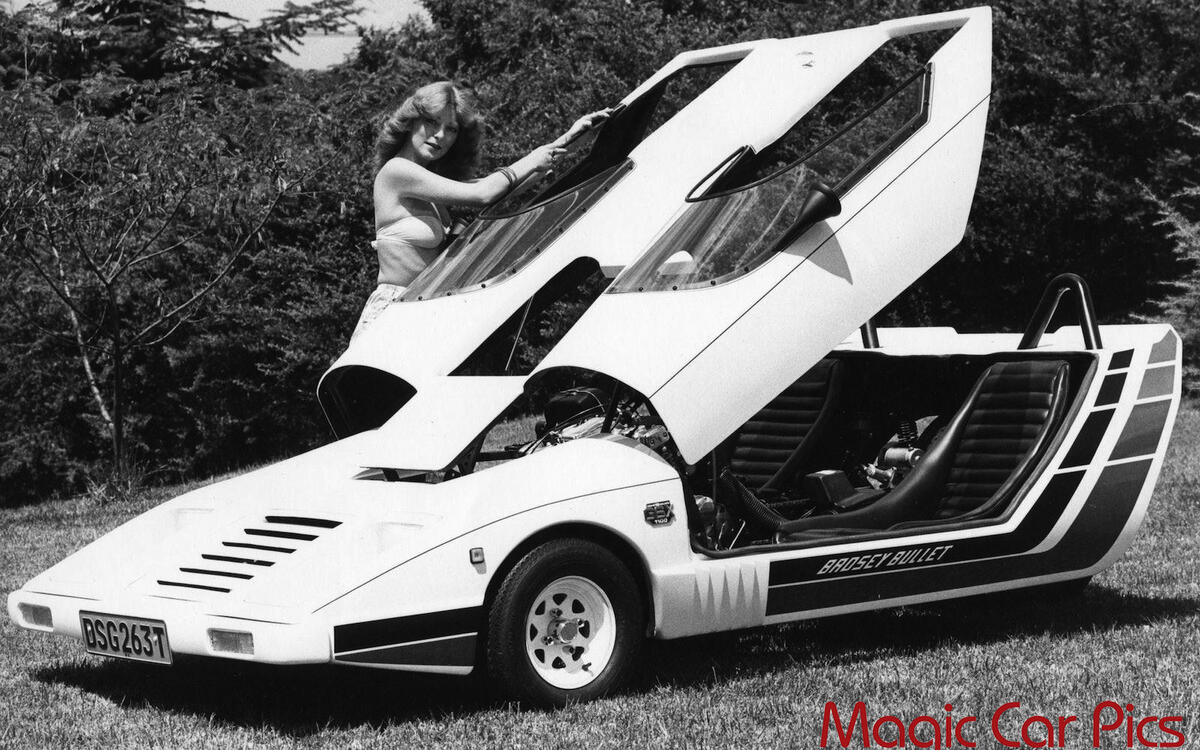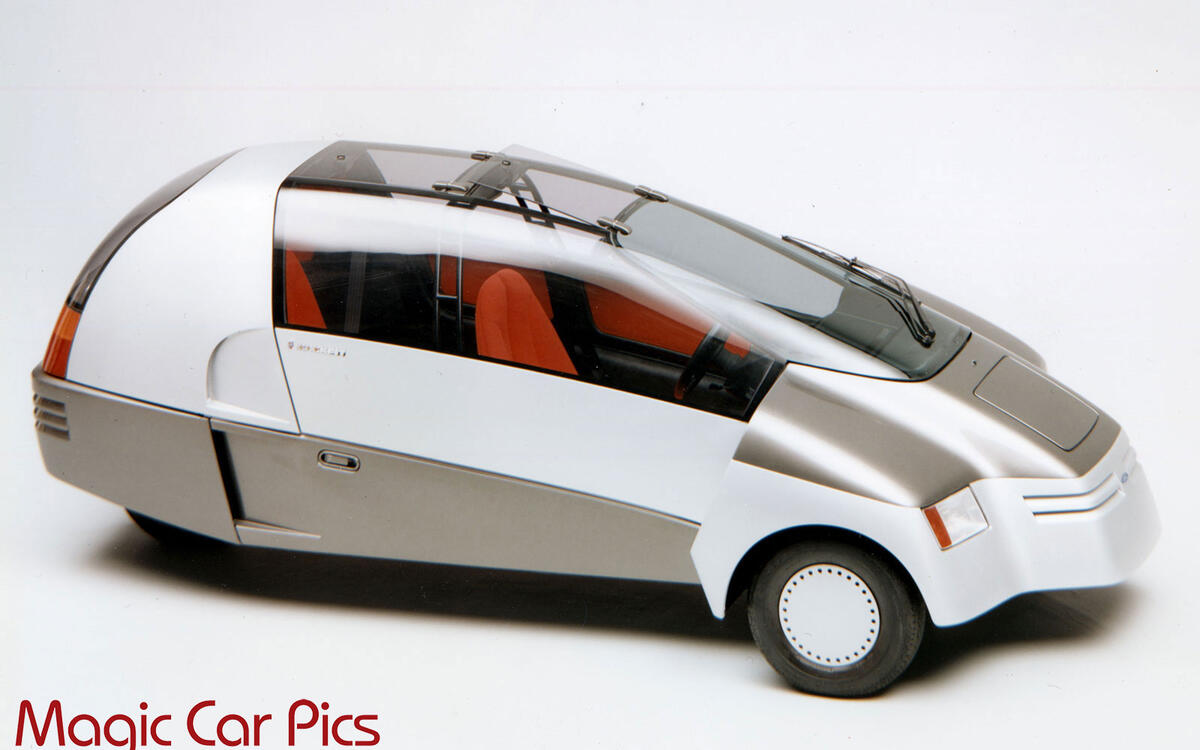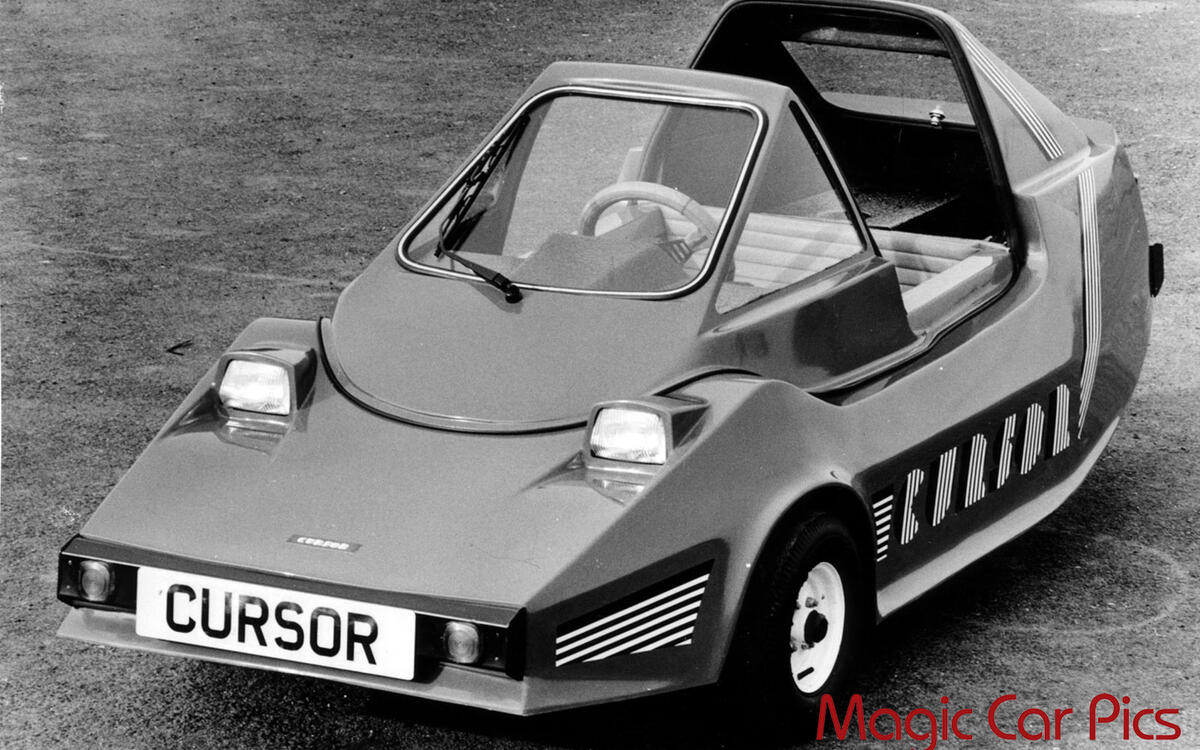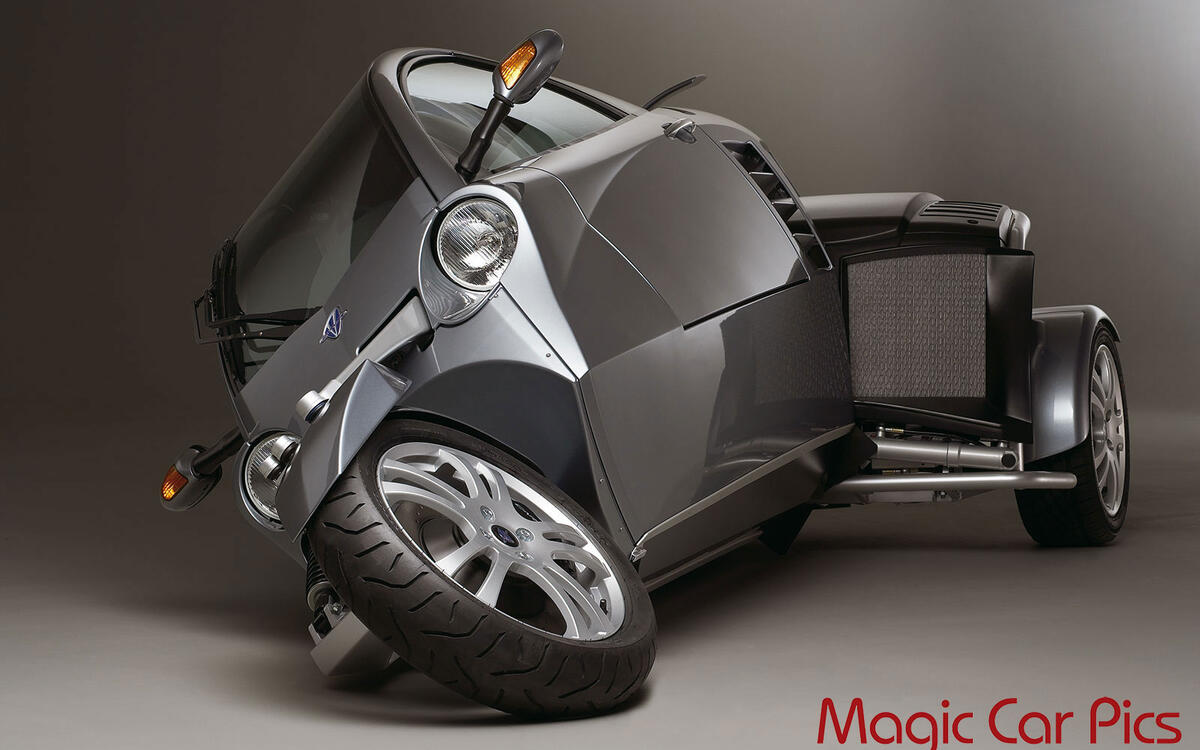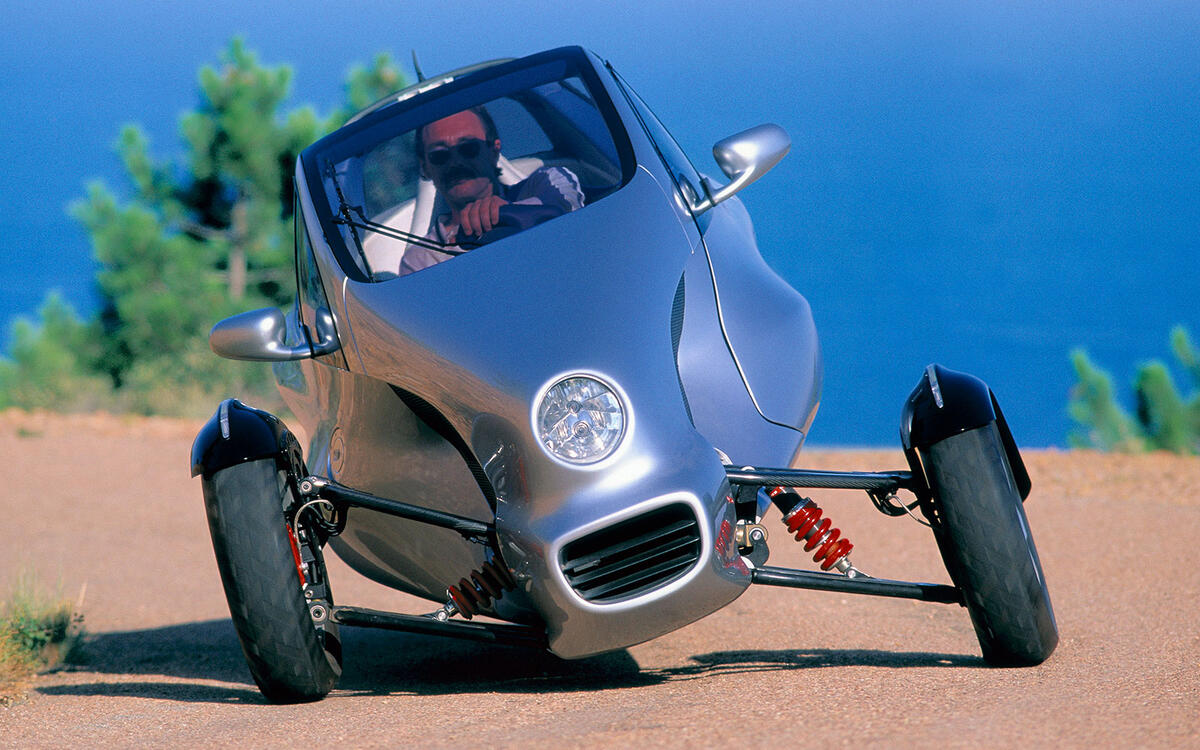 Slide of
Slide of
The first cars sported just three wheels, and since then more than 1200 different models of three-wheeler have been produced.
But how many can you name? Morgan and Reliant are the go-to brands, but after that most car fans will struggle to name many. So read on and prepare to be enlightened on some of the most bizarre vehicles ever created, including the Fend Flitzer, Brutsch Spatz and the Tourette (yes, really!).
Morgan (1909)
We might as well start with the company best known for producing cars with one wheel missing. Morgan started out in 1909 and soon built up a following for its cars which were successful in trialling as well as racing. As you can see, despite the diminutive proportions and slightly low wheel count, there was still enough room for adults to travel in luxury. There was even a roof.
 Slide of
Slide of
Morgan Supersports (1933)
Sorry to make it two in a row but A) in the pre-war years Morgan hogged the three-wheeler limelight and B), as the quintessential three-wheeler we had to include the Supersports. Capable of over 80mph, these cars were far more rugged than you’d expect.
 Slide of
Slide of
Brogan (1946)
Ohio-based Frank Brogan set up a new company in 1946 to build a utilitarian three-wheeler named after himself – and why wouldn’t you want to name a car after yourself when it looks this good? This is actually his second three-wheeler; the first featured its single wheel at the front and an air-cooled 10bhp single-cylinder engine. This later car switched the single wheel to the back. Brogan built about 30 cars in all; we reckon it’s time for a revival.
 Slide of
Slide of
Davis Divan (1947)
Not all three-wheelers have to be tiny; the Davis Divan was 4.7 metres long, weighed 1111kg (2444 lb) and was powered by a 2.2-litre engine. It could also seat four abreast on its single bench seat so it was a tad unstable, which is why no production cars were built – but 17 prototypes were.
 Slide of
Slide of
Invacar (1947)
At the end of World War 2, many former soldiers in Britain were left with serious injuries. If you were one of them, this was the car for you, though if you had lost an arm you’d have to pay 25% more. There were six iterations of the Invacar in five years, then in 1952 came the Mk8 (there was no Mk7) which was seriously upmarket as it featured some rudimentary weather protection.
 Slide of
Slide of
Bond Minicar (1948)
Lawrie Bond offered the only British-made three-wheeler in 1948, apart from Morgan. Built for ultimate economy there was no rear suspension, no doors, a plastic windscreen, no front brakes and a 6bhp 122cc engine. Unsurprisingly, the car sold like hot cakes, leading Bond to take his car upmarket with a 197cc single-cylinder engine.
 Slide of
Slide of
Fend Flitzer (1949)
Fritz Fend worked for Messerschmitt during WW2. When hostilities ended he decided to start building pedal-powered three-wheelers for injured soldiers. The first cars were sold in 1948 but a year later this more sophisticated Mk2 version entered production with a 2.5bhp 98cc engine that could whisk the Flitzer up to 38mph. The most bizarre feature was the inflatable ribbed roof; the Flitzer Mk2 was enticing enough to part 252 people from their money.
 Slide of
Slide of
Velorex (1950)
Based in Czechoslovakia, the Stransky brothers built their first Velorex prototype in 1943 but production didn’t start until 1950. A steel-tube spaceframe housed a 175cc engine (later 250cc then 350cc), over which were clipped canvas sheets to keep out the elements. It was light, frugal and surprisingly quick, and despite a poor Euro NCAP rating more than 15,000 had been sold by the time production ended in 1971.
 Slide of
Slide of
Fuldamobil N-2 (1952)
The original Fuldamobil of 1950 used the same manufacturing techniques as contemporary caravans. Things improved with the N-1 of 1951 and by the time the N-2 arrived a year later, this super-sleek 2+2 was positively sexy. It was a road burner too, with a 9.5bhp 359cc single-cylinder engine.
 Slide of
Slide of
Daihatsu Bee (1951)
Most Japanese car makers started small; Daihatsu’s first passenger car was this three-wheeler that was powered by a rear-mounted 804cc air-cooled flat-twin. So it probably drove just like a shrunken 911. At over four metres long it was a big car for such a tichy engine which is why it topped out at just 49mph. About 300 were made; do any survive?
 Slide of
Slide of
Bond Minicar (1952)
Having sold almost 3500 copies of his previous design, Lawrie Bond came up with this; the far more upmarket Minicar MkC. There was now a door (just the one though, for the passenger), front brakes and full-width styling, so from the front the Bond looked like a proper car. Onlookers weren’t fooled for long though.
 Slide of
Slide of
AC Petite (1952)
It seems incredible that the company that brought us the thundering Cobra 427 also built this 40mph monster. While the Petite was made of steel, the later Model 70 was made of plastic; that’s the blue invalid car that was so prevalent on UK roads in the 1970s. The Model 70 was so unsafe that it was banned from production in 1978 – and from British roads altogether in 2003.
 Slide of
Slide of
Allard Clipper (1953)
Just like AC, Allard was a company that built sports cars powered by huge American V8s, so the Clipper was something of a departure. One of the first cars ever to be made of glassfibre. A 346cc engine knocked out all of 8bhp but the Clipper was hideously unreliable, which is why hardly any were made.
 Slide of
Slide of
SNCAN Inter (1953)
SNCAN was a French aircraft builder that switched its attention to making cars. Just like the Messerschmitt, the Inter seated two in tandem and was powered by a 175cc engine. Early examples featured front wheels that could be folded in so the car could be pulled through a standard front doorway, enabling it to be stored inside.
 Slide of
Slide of
Brutsch Spatz (1954)
Egon Brutsch was one of the most prolific microcar designers of the 1950s, but he didn’t enjoy much commercial success. His first car was the Spatz (Sparrow), with a 191cc single-cylinder engine. Instead of a chassis the Spatz featured a glassfibre monocoque – which fell apart because it was too weak. This led to the car being banned in Germany, which proved something of a setback.
 Slide of
Slide of
Gordon (1954)
Vernon Industries was the company behind the football pools– the company that made people very wealthy overnight. It also made this contraption, which presumably no pools winner ever rushed out to buy. The 197cc engine sat outside the bodywork on the driver’s side and this provided a 45mph top speed. Despite this, Vernons claimed the Gordon was “Britain’s finest three-wheeler family car”. We beg to differ.
 Slide of
Slide of
Avolette (1955)
Another Brutsch creation, the Avolette was licensed by French company Air Tourist, which sexed things up to make the car more appealing, as is evident from this picture. The standard powerplant was a 175cc single-cylinder unit, but for those who craved performance a 250cc engine was optional
 Slide of
Slide of
Messerschmitt KR200/201 (1955)
When Willy Messershmitt was banned from making aircraft after the end of World War 2, he moved into car manufacturing. His first creation was the 1953 KR175, of which nearly 20,000 were made by the time its successor the KR200 appeared in 1955. This featured a 191cc engine and tandem seating for two. About 30,000 of these were sold by the time production ended in 1964.
 Slide of
Slide of
Brutsch Mopetta (1956)
Perfect for the person with a death wish who was in no hurry, the Mopetta packed a 49cc engine and could speed all the way to 27mph. Just 1.7 metres long and all of 88cm wide, for some reason the Mopetta wasn’t a strong seller, with just 14 made.
 Slide of
Slide of
Heinkel Kabine (1956)
As the advert says, the Heinkel was exceedingly fast and came with a spacious and comfortable interior; no wonder the family inside this one look so happy. One of the most famous and popular of all bubble cars, the Heinkel was also sold as the Trojan, with around 30,000 examples made in all.
 Slide of
Slide of
Tourette (1956)
So many jokes, so little space... Built by the southern England-based Progress Supreme Company, the Tourette was tiny but could supposedly seat three abreast. With all of 7.6bhp available from the 197cc engine the 195kg car was reputedly capable of 55mph. Presumably on a very steep downhill gradient. Just 35 were made in 1956-1957.
 Slide of
Slide of
Rollera (1956)
If the Mopetta was a washout in terms of its popularity it was nothing compared with the Rollera, of which just eight were sold. It was effectively a longer and wider two-seater version of the Mopetta, and once production ended, the Rollera was licensed to Sté Rollera Francaise which built a few more. These cars have become hugely collectible with the car pictured sold by RM Sothebys in 2013 for a whopping $63,250. A Mopetta was sold in the same auction for $66,125.
 Slide of
Slide of
Bond Minicar (1957)
Less than a decade after he introduced his Minicar, Lawrie Bond had sold almost 14,000 of them; that’s austerity for you. The final design appeared in 1957, offered in saloon, convertible and estate forms during its nine-year lifespan. Bond had finally discovered true luxury; this Minicar had a door on each side, a throbbing 246cc engine and even wind-up windows on later cars.
 Slide of
Slide of
Fuji Cabin (1957)
Built by Tokyo-based Fuji Toshuda Motors, the Cabin was one of Japan’s most successful microcars – which isn’t saying much as only 85 were made. The 5.5bhp 123cc two-stroke single-cylinder engine gave a top speed of 37mph; the car pictured was sold by RM Sothebys in 2013 for a whopping $126,500 (around £85,000 at the time).
 Slide of
Slide of
Coronet (1957)
The Coronet was an attempt at producing a microcar with big-car styling and comfort, which is why it was advertised as “the world’s best three-wheeler”. And who are we to argue? The 328cc engine could take this three-seater up to 57mph and despite the high price when it was launched, around 250 were made between 1957 and 1960.
 Slide of
Slide of
Scootacar (1958)
As bubble cars became big news in mainland Europe, Scootacar put this confection into production. There were three iterations, all basically the same but the first two got a 197cc engine which ballooned to a 324cc unit for the final version. Around 1000 Scootacars were built between 1958 and 1965.
 Slide of
Slide of
Berkeley T60 (1959)
We’ve already encountered the delights of Lawrie Bond. In 1955 he approached caravan maker Berkeley with a view to collaborating on a pint-sized sports car. The result was the four-wheeled B65 which four years later became the three-wheeled T60. Very nippy and enormous fun to drive, the T60 proved a smash hit with 1750 sold in the first year. But Berkeley went bust in 1960 when its caravan sales slumped, and it was all over.
 Slide of
Slide of
Reliant MkVI (1960)
If ever there was a company renowned for its three-wheelers, it’s Britain’s Reliant – largely because it built almost 200,000 of them over a 65-year production run. The first passenger cars came in 1952 and they were pretty basic, but by 1960 the factory was churning out this sporty little number. Sleek and stylish, the MkVI was a big success, with 8478 built by the time production ended in 1962.
 Slide of
Slide of
Nobel 200 (1959)
What started out as the German-built Fuldamobil S-7 became the British-made Nobel 200 in 1959. Offered with three wheels or four, the Nobel featured a glassfibre bodyshell made by the Bristol Aircraft Company. Available in kit or fully-built forms, around 1000 Nobels were made before the plug was pulled in 1962.
 Slide of
Slide of
Peel P50 (1962)
Marginally more high-tech than a skateboard, the Peel P50 is still listed as the world’s smallest passenger car by the Guinness Book of Records. Capable of seating one in discomfort, a 49cc engine buzzed away under the driver; it could take the Peel all the way to 30mph. Original P50s are very highly prized but the car is back in production once more – now powered by electricity. Suddenly the Reva G-Whiz looks sophisticated.
 Slide of
Slide of
GM Runabout (1964)
Most three-wheelers of the 1960s were cheap, functional cars but GM showed that the genre could also be sleek and appealing with this concept. Shown at the 1964 World Fair, the Runabout’s single front wheel could be turned through 180 degrees so the car could turn in its own length. The back of the car also incorporated a removable shopping trolley..
 Slide of
Slide of
Peel Trident (1965)
Buoyed by the success of the P50, Peel’s encore was the Trident. Looking like it had driven straight out of the Jetsons, the Trident could seat two side by side, with power still supplied by a 49cc engine. Once again, the Trident went back into production in 2010, and as with the P50, motive power was supplied by an electric motor rather than a petrol engine.
 Slide of
Slide of
ABC Trimini/Tricar (1968)
If you’ve always thought that the Mini has one wheel too many, the Trimini was just the thing. Created by Auto Body Craft in the West Midlands, the Mini’s entire front end was retained and half of a Mini rear subframe was grafted onto the back end along with a new glassfibre body tub. Weighing 205kg less than a regular Mini, the Trimini was swift and at £400 for the conversion it was tempting enough to part 25 people from their cash.
 Slide of
Slide of
Bond Bug (1970)
Reliant’s designer Tom Karen had long wanted the company to build something a bit far out, and when it bought microcar maker Bond, it was the perfect opportunity. If the car tanked it wasn’t a Reliant – it was a Bond. In the event it did okay with 2269 being built up to 1973, each one powered by a 700cc four-cylinder engine.
 Slide of
Slide of
Reliant Robin (1973)
The Robin replaced the Regal which is best known for its star part in the BBC comedy show Only Fools and Horses. The butt of endless jokes, the Robin was powered by a 748cc engine, enlarged to 848cc in 1975. The Rialto replaced the Robin in 1981 but the latter was revived in 1989 and it would stay in production until Reliant faded away in 2001.
 Slide of
Slide of
Stimson Scorcher (1976)
With three wheels, a 254kg kerb weight and a top speed of around 100mph, the Stimson Scorcher was capable of providing thrills galore. The brainchild of Barry Stimson, around 30 of these wacky machines were built, each one powered by a 998cc Mini engine. They’ve become very collectible, so if you happen to see one at the right price...
 Slide of
Slide of
Badsey Bullet (1981)
Bill Badsey was an ambitious South African who claimed that his Bullet was capable of 200mph – 150mph was probably nearer the truth. Powered by a Suzuki six-cylinder motorcycle engine, the Bullet was supposed to be officially imported to the UK from 1982, but it doesn’t seem that any cars ever actually made it here.
 Slide of
Slide of
Ghia Cockpit (1981)
The Cockpit represented the future of urban commuting when it was unveiled at the 1981 Geneva motor show. Capable of seating two adults in tandem, at the back was a 12bhp 200cc single-cylinder engine capable of giving 75mpg. Just the one show car was made though, sadly.
 Slide of
Slide of
Reliant Rialto (1981)
By the early 1980s the Robin was looking dated, so Reliant drafted in International Automotive Design with the brief from Hell; come up with a sexy three-wheeler. It’s fair to say that IAD succeeded – and how – with a car that was super-sleek and didn’t look at all like a Robin with a new nose.
 Slide of
Slide of
Lomax 223 (1983)
When Nigel Whall created the Lomax from a redundant Citroen 2CV he probably didn’t realise that his Lomax would become one of the most popular kit cars ever, with more than 3500 sold. A 2CV floorpan was mated to a glassfibre bodyshell with no doors or roof. The car weighed just 400kg(880 lb), with its 31bhp 602cc flat-twin engine giving ample performance.
 Slide of
Slide of
Sinclair C5 (1984)
New British regulations from August 1983 allowed electrically powered cycles of fewer than four wheels, under 60kg (132 lb) in weight and powered by a motor of up to 250W, to be used on the road under powered control at a maximum of 15mph. No tax disc, licence, insurance, helmet or MOT was required, and anyone aged 14 or over could drive one.
The British personal computer pioneer Clive Sinclair seized an opportunity that wasn’t there with a vehicle that was impractical and overpriced. It bombed, forcing Sinclair to sell his computer business to his great rival, Alan Sugar of Amstrad, in 1986.
 Slide of
Slide of
Replicar Cursor (1985)
Alan Hatswell formed Replicar in 1981 to build Bugatti, Ferrari and Jaguar-inspired kit cars. Then he came up with the Cursor – a single-seat three-wheeler powered by a Suzuki 49cc moped engine. With a 30mph top speed the Cursor could legally be driven by 16-year olds. About 100 Cursors were built between 1985 and 1987, with a few later cars being two-seaters.
 Slide of
Slide of
Volkswagen Scooter (1986)
The Scooter was a refreshing take on the urban commuter car that still looks modern even though it’s over 30 years old. Powered by a 1043cc Polo engine that could take it all the way to 125mph, the Scooter featured gull-wing doors that could be removed altogether to create a sort of convertible.
 Slide of
Slide of
Grinnall Scorpion III (1992)
Still in production, the Scorpion III first appeared more than a quarter of a century ago. The basics are still the same; a square-tube steel chassis uses Ford front suspension and a BMW motorbike swing arm at the rear, with power coming from a BMW bike engine. Well made and enormous fun to drive, it’s easy to see the Grinnall’s appeal.
 Slide of
Slide of
Corbin Sparrow (1996)
When Mike and Tom Corbin launched their Sparrow in 1996 it was one of the few electric cars on the market. Around 350 of these single-seater commuter cars were built up to 2003. By that point the company had also introduced the petrol-engined Merlin three-wheeler, but just a dozen of these were made before Corbin went bust.
 Slide of
Slide of
Carver One (1997)
Three-wheelers tend to be a bit bonkers but the Carver took things to the next level, with a body that leaned into corners so it constantly looked like it was tipping over. About 200 cars were made before the company went bust in 2009, but as you’ll see later, this wasn’t the last we heard of the Carver One...
 Slide of
Slide of
Mercedes-Benz F300 Lifejet (1997)
Mercedes might be a very conservative company, but that doesn’t stop it letting its designers have some fun when it comes to concept cars. They were certainly let off the leash for this one; a two-seater three-wheeler with a 1.6-litre engine that could do 130mph. A computer allowed the cornering angle to be controlled, with the body able to tilt by up to 30 degrees, presumably ensuring that any occupants will feel sick by the time they get out.
 Slide of
Slide of
PAL-V (2004)
The first examples of the Personal Air and Land Vehicle are scheduled to be delivered to their expectant buyers this year – 14 years after the project first began. The PAL-V is essentially a gyrocopter based on the Carver One that we saw earlier, a 100bhp petrol engine in drive mode gives a top speed of 100mph on the road. When flying the engine’s power output doubles to 200bhp and the top speed increases to 112mph.
 Slide of
Slide of
Peugeot 20Cup (2005)
Offering a brief diversion from reality, Peugeot whisked the covers off the 20Cup in 2005 to show what a three-wheeler with the Pug corporate face would look like. It looked pretty appealing, and with a kerb weight of under 500kg along with a 168bhp turbocharged 1.6-litre petrol engine it would have been a hoot to drive.
 Slide of
Slide of
Volkswagen GX-3 (2006)
When VW unveiled the GX-3 at the 2006 Los Angeles Auto Show the assumption was that this was merely a show car, but the ultra-conservative company looked seriously into putting the car into production. A 1.6-litre Lupo GTi engine gave 0-62mph in 5.7 seconds a 125mph top speed, but litigation concerns put paid to the project.
 Slide of
Slide of
Morgan Three-Wheeler (2012)
We’re going to (almost) finish where we started; with the car that has come to sum up the three-wheeler market in the 21st century. A brilliant recreation of the original, the modern-day Morgan is unfeasibly fun to drive; it’ll put a smile on your face – and those around you – like no hypercar ever could.
 Slide of
Slide of
Morgan EV3 (2018)
Bringing the three-wheeler story right up to date is this, the latest thing from Morgan and where the three-wheeler story should end – with electric power. First shown in 2015, the first deliveries of this 500kg (1100 lb) three-wheeled EV should be delivered to owners later this year. You can bet that Autocar will be the first to drive it – and we can’t wait.
There were a lot more three-wheelers than the Reliant Robin - Autocar pays its respects to a lost world.
Advertisement

